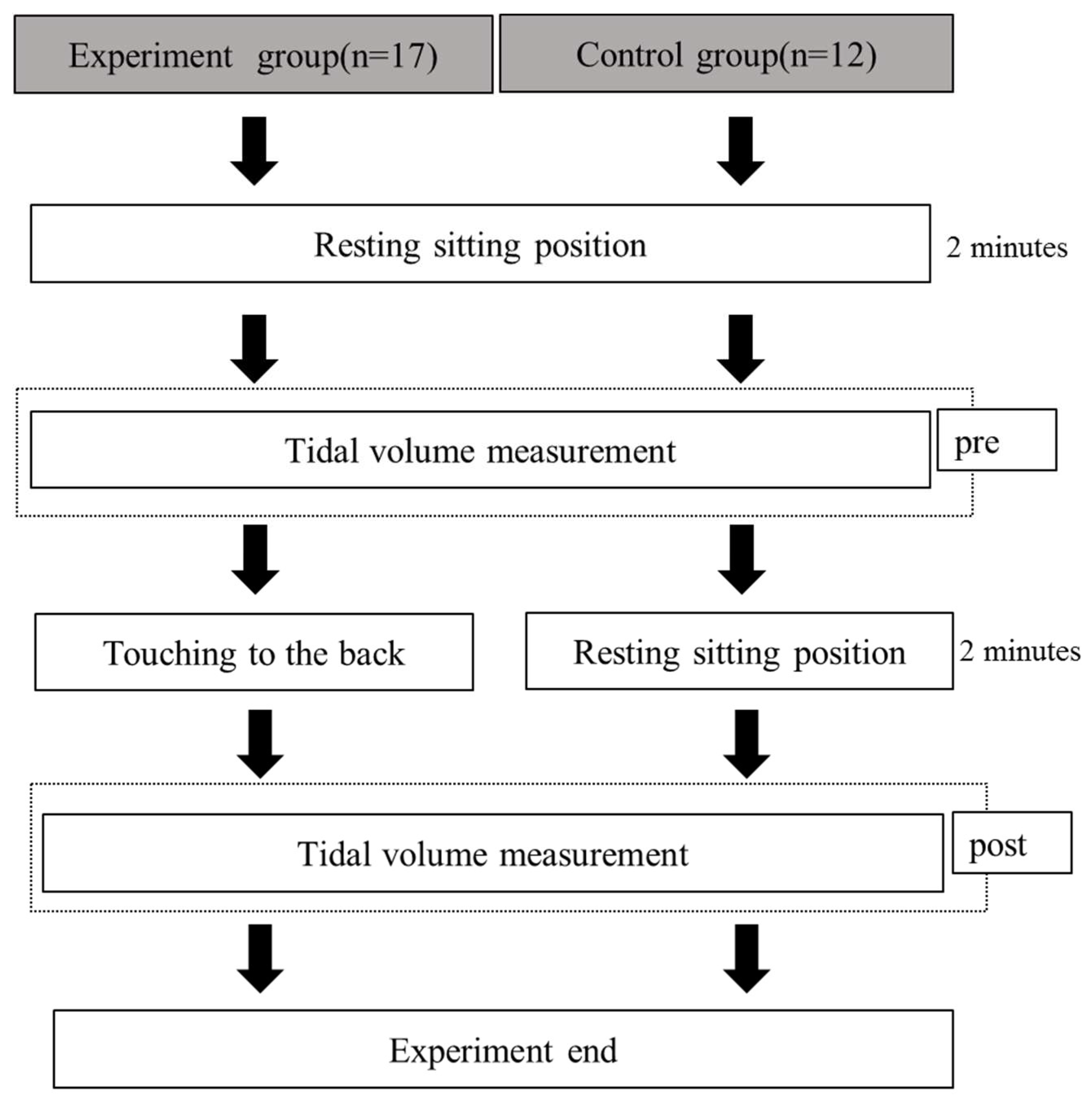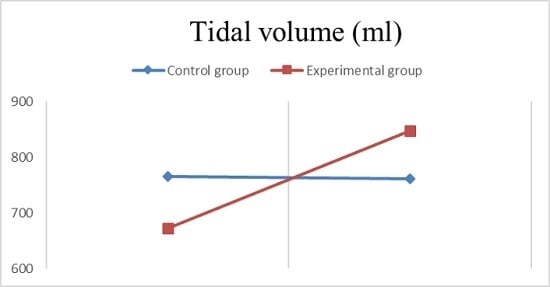Effects of Back Touching on Tidal Volume
Abstract
:1. Introduction
1.1. Effect of Touching on a Back
1.2. Relationship between Breathing and Stress
1.3. Tidal Volume
1.4. Purpose of the Research
2. Materials and Methods
2.1. Experiment Participants and Ethical Consideration
2.2. Physiological Index
2.3. Method of Touching and a Therapist
2.4. Procedure
2.5. Statistical Analysis
3. Results
4. Discussion
5. Limitations and Future Development
6. Conclusions
Author Contributions
Funding
Conflicts of Interest
References
- Kawahara, Y.; Okuda, K. A Systematic Review on Touch/Massage in Nursing. Jpn. J. Nurs. Art Sci. 2009, 8, 91–100. [Google Scholar]
- Serife, K.; Emine, K. Effects of back massage on chemotherapy-related fatigue and anxiety Supportive care and therapeutic touch in cancer nursing. Appl. Nurs. Res. 2013, 26, 210–217. [Google Scholar]
- Maruyama, K.; Shimoju, R.; Ohkubo, M.; Maruyama, H.; Kurosawa, M. Tactile skin stimulation increases dopamine release in the nucleus accumbens in rats. J. Physiol. Sci. 2012, 62, 259–266. [Google Scholar] [CrossRef] [PubMed]
- Tanaka, K.; Kozu, R.; Kitagawa, C.; Asai, M. A manual breathing assist proficiency scale for therapists Interrater reliability and elements which is related to tidal volume. J. Jp. Soc. Resp. Care Rehab 2015, 25, 95–98. [Google Scholar]
- Kozu, R. Standardization and New Development in Respiratory Physiotherapy for Pulmonary Disorders. Phys. Ther. Jpn. 2014, 41, 222–225. [Google Scholar]
- Lehrer, P.; Carr, R.; Smetankine, A.; Vaschillo, E.; Peper, E.; Porges, S.; Edelberg, R.; Hamer, R.; Hochron, S. Respiratory sinus arrhythmia versus neck/trapezius EMG and incentive inspirometry biofeedback for asthma, a pilot study. Appl. Psychophysiol. Biofeedback 1997, 22, 95–109. [Google Scholar] [CrossRef]
- Porges, S. Polyvegal Theory Polygenetic substrates of a social nervous system. Int. J. Psychophysiol. 2001, 42, 123–146. [Google Scholar] [CrossRef]
- Terai, K.; Takeuchi, H.; Umezawa, A. Effects of respiratory self-control on cardiovascular and psychological reactivity to laboratory stressors. Jpn. J. Physiol. Psychol. Psychophysiol. 2005, 23, 207–215. [Google Scholar] [CrossRef]
- Sakakibara, M. Why is the abdominal breathing method good for health? An autonomic mechanism related to heart rate variability and psychological effects. Bull. Tokai Gakuen Univ. 2011, 16, 105–122. [Google Scholar]
- Wielgosz, J.; Schuyler, B.; Lutz, A.; Davidson, R. Long-term mindfulness training is associated with reliable differences in resting respiration rate. Sci. Rep. 2016, 6, 27533. [Google Scholar] [CrossRef] [Green Version]
- Takeuchi, M. A Study on the Breathing Capacity of Athletes The proceedings of the Hoshi College of Pharmacy. Proc. Hoshi Coll. Pharm. 1971, 13, 115–123. [Google Scholar]
- Hallett, S.; Ashurst, J.V. Physiology, Tidal Volume; StatPearls Publishing: Treasure Island, FL, USA, 2019. [Google Scholar]
- Vlemincx, E.; Van Diest, I.; De Peuter, S.; Bresseleers, J.; Bogaerts, K.; Fannes, S.; Li, W.; Van den Bergh, O. Why do you sigh? Sigh rate during inducedstress and relief. Psychophysiology 2009, 46, 1005–1013. [Google Scholar] [CrossRef] [PubMed]
- Inoue, K.; Yamamoto, Y.; Sugamura, G. A sigh increases motivation for difficult and monotonous tasks. The effect of one-time voluntary brief exhalation on relief and achievement needs. Jpn. J. Psychol. 2016, 87, 133–143. [Google Scholar] [CrossRef]
- Masutani, M.; Masutani, N. Consideration for deep breathing from the viewpoint of health psychology. Bull. Keiwa Coll. 2010, 19, 93–99. [Google Scholar]
- Triscoli, C.; Croy, I.; Olausson, H.; Sailer, U. Touch between romantic partners: Being stroked is more pleasant than stroking and decelerates heart rate. Physiol. Behav. 2017, 177, 169–175. [Google Scholar] [CrossRef] [PubMed]
- Loken, L.; Wessberg, J.; Morrison, I.; McGlone, F.; Olausson, H. Coding of pleasant touch by unmyelinated afferents in humans. Nat. Neurosci. 2009, 12, 547–548. [Google Scholar] [CrossRef] [PubMed]
- Liljencrantz, J.; Strigo, I.; Ellingsen, D.; Kramer, H.; Lundblad, L.; Nagi, S.; Leknes, S.; Olausson, H. Slow brushing reduces heat pain in humans. Eur. J. Pain 2017, 21, 1173–1185. [Google Scholar] [CrossRef]
- Hitomi, T.; Yachi, C.; Yamacuchi, H. Attempt of Moisturizing Care of the Lower Legs of Parkinsons Disease a Patient with Restless Legs Syndrome. Jpn. J. Nurs. Art Sci. 2019, 18, 36–41. [Google Scholar]
- Hitomi, T.; Yachi, C.; Yamacuchi, H. An Experiment on the Psychological and Physiological Effects of Skin Moisturization on Lower Legs-In Expectation of Application to Nursing Practice at Hospitals. Behav. Sci. 2018, 8, 91. [Google Scholar] [CrossRef]
- Hitomi, T.; Yachi, C.; Yamacuchi, H. Verification of Effect of Moisturizer Application on Cruris-Influence on Relaxation Effect. Jpn. J. Nurs. Art Sci. 2018, 17, 90–94. [Google Scholar]
- Shimizu, H. An introduction to the statistical free software HAD: Suggestions to improve teaching, learning and practice data analysis. J. Media Inf. Commun. 2016, 1, 59–73. [Google Scholar]
- Hayano, J.; Okada, A.; Yasuma, S. Biological Significance of Heart Rate Variability. Artif. Organs 1996, 25, 870–880. [Google Scholar]
- McGlone, F.; Wessberg, J.; Olausson, H. Discriminative and affective touch: Sensing and feeling. Neuron 2014, 82, 737–755. [Google Scholar] [CrossRef] [PubMed]
- Ota, K.; Ishikawa, Y.; Takata, M.; Joe, K. A Stress Indexing Method by Respiratory Variability Analysis. Inf. Proc. Soc. Jpn. 2015, 115, 115–120. [Google Scholar]
- Vlemincx, E.; Taelman, J.; De Peuter, S.; Van Diest, I.; Van den Bergh, O. Sigh rate and respiratory variability during mental load and sustained attention. Psychophysiology 2011, 48, 117–120. [Google Scholar] [CrossRef]


| Variable Name | n | Mean | Median | SD | Varinace | Min | Max |
|---|---|---|---|---|---|---|---|
| Control group-pre | 12 | 0.765 | 0.755 | 0.162 | 0.026 | 0.460 | 1.000 |
| Control group-post | 12 | 0.763 | 0.730 | 0.153 | 0.023 | 0.510 | 1.000 |
| Experiment group-pre | 17 | 0.674 | 0.650 | 0.123 | 0.015 | 0.500 | 1.000 |
| Experiment group-post | 17 | 0.848 | 0.900 | 0.167 | 0.028 | 0.470 | 1.070 |
| Control Group | Experiment Group | ||||||
|---|---|---|---|---|---|---|---|
| Pre | Post | Post-pre | Pre | Post | Post-pre | ||
| 1 | 0.96 | 0.72 | −0.24 | 1 | 0.69 | 0.93 | 0.24 |
| 2 | 0.85 | 1.00 | 0.15 | 2 | 0.75 | 0.99 | 0.24 |
| 3 | 0.78 | 0.95 | 0.17 | 3 | 0.62 | 1.01 | 0.39 |
| 4 | 0.70 | 0.71 | 0.01 | 4 | 0.60 | 0.90 | 0.30 |
| 5 | 1.00 | 0.64 | −0.36 | 5 | 0.68 | 0.67 | −0.01 |
| 6 | 0.71 | 0.61 | −0.10 | 6 | 0.52 | 0.84 | 0.32 |
| 7 | 0.46 | 0.91 | 0.45 | 7 | 0.61 | 0.85 | 0.24 |
| 8 | 0.65 | 0.90 | 0.25 | 8 | 1.00 | 0.94 | −0.06 |
| 9 | 0.59 | 0.64 | 0.05 | 9 | 0.77 | 1.07 | 0.30 |
| 10 | 0.75 | 0.51 | −0.24 | 10 | 0.65 | 0.60 | −0.05 |
| 11 | 0.97 | 0.82 | −0.15 | 11 | 0.65 | 0.73 | 0.08 |
| 12 | 0.76 | 0.74 | −0.02 | 12 | 0.50 | 0.76 | 0.26 |
| Mean | 0.00 | 13 | 0.75 | 0.99 | 0.24 | ||
| 14 | 0.80 | 0.71 | −0.09 | ||||
| 15 | 0.65 | 0.95 | 0.30 | ||||
| 16 | 0.50 | 0.47 | −0.03 | ||||
| 17 | 0.71 | 1.01 | 0.30 | ||||
| Mean | 0.17 | ||||||
| Variable Name | Partial η2 | 95% CI | F Value | P Value |
|---|---|---|---|---|
| Touching terms | 0.00 | 0.000, 0.048 | 0.00 | 0.948 |
| Pre-Post | 0.17 | - | 5.57 | 0.026 * |
| Interaction | 0.18 | - | 5.89 | 0.022 * |
| Variable Name | Standard Error | Effect Size d | 95% CI | t Value | P Vaule |
|---|---|---|---|---|---|
| Experiment group (pre)-control group (pre) | 0.057 | 1.161 | 0.129, 2.194 | 1.604 | 0.114 |
| Experiment group (post)-control group (post) | 0.057 | −0.794 | −1.542, −0.045 | 1.504 | 0.138 |
| Experiment group (pre)- Experiment group (post) | 0.047 | −1.115 | −1.820, −0.411 | 3.721 | 0.001 ** |
| control group (pre)-control group (post) | 0.056 | 0.022 | −1.045, 1.089 | 0.045 | 0.965 |
© 2019 by the authors. Licensee MDPI, Basel, Switzerland. This article is an open access article distributed under the terms and conditions of the Creative Commons Attribution (CC BY) license (http://creativecommons.org/licenses/by/4.0/).
Share and Cite
Hitomi, T.; Yachi, C.T.; Yamaguchi, H. Effects of Back Touching on Tidal Volume. Psych 2019, 1, 412-419. https://doi.org/10.3390/psych1010031
Hitomi T, Yachi CT, Yamaguchi H. Effects of Back Touching on Tidal Volume. Psych. 2019; 1(1):412-419. https://doi.org/10.3390/psych1010031
Chicago/Turabian StyleHitomi, Taichi, Chigusa Theresa Yachi, and Hajime Yamaguchi. 2019. "Effects of Back Touching on Tidal Volume" Psych 1, no. 1: 412-419. https://doi.org/10.3390/psych1010031






